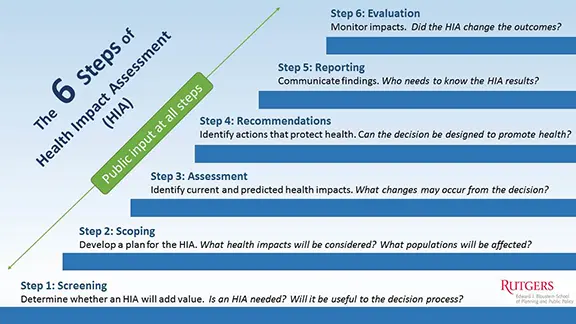 Rutgers University’s Edward J. Bloustein of Planning and Public Policy, in collaboration Rutgers Biomedical and Health Sciences, has announced the launch of theNew Jersey Health Impact Collaborative (NJHIC), a partnership dedicated to promoting the integration of public health impacts into community planning, design, and decision-making.
Rutgers University’s Edward J. Bloustein of Planning and Public Policy, in collaboration Rutgers Biomedical and Health Sciences, has announced the launch of theNew Jersey Health Impact Collaborative (NJHIC), a partnership dedicated to promoting the integration of public health impacts into community planning, design, and decision-making.
The goal of the NJHIC is to build partnerships that enhance opportunities to conduct health impact assessments that inform state, regional and local decisions, so that these decisions result in healthier communities and citizens. Health impact assessment (HIA) is a fast-growing practice that provides practitioners and policymakers with the tools to consider the health outcomes of decisions. By combining scientific data, health expertise and public input, HIAs identify and assess the potential positive and negative health effects of decisions related to policies, programs or projects.
“Health impact assessment is an approach to policy development that builds consideration of public health impacts into decision-making in non-health policy areas such as transportation, housing, environment, energy and economic development,” said James W. Hughes, dean of the Bloustein School. “The convergence of public policy, urban planning, and public health at the Bloustein School puts Rutgers University at the forefront of helping public health practitioners understand the importance of community design in health, as well as the importance of their role in the overall planning process.”
“The increasing recognition of the significant role of social determinants in predicting health outcomes brings issues of the built environment and its ability to positively or negatively impact health into sharp focus,” said Denise V. Rodgers, MD, Vice Chancellor for Interprofessional Programs at Rutgers Biomedical and Health Sciences. “The New Jersey Health Impact Collaborative will allow HIA consultants from Rutgers to help decision makers plan projects that are beneficial to the health of families and communities in our state and throughout the country.”
The collaborative currently has two projects underway. The Middlesex Greenway HIA, a rails-to-trails project within the communities of Metuchen, Edison, and Woodbridge in Middlesex County, is investigating the potential health impacts associated with increasing utilization of and extending the Greenway by implementing sustainable connections. Project partners will make recommendations for how the Greenway can be used to protect and promote the health of its users as well as how its increased use will benefit local businesses and downtowns.
The Bloomfield Avenue Complete Corridor Plan is a study of a 4.3 mile segment of Bloomfield Avenue from the Garden State Parkway in Bloomfield to Grove Avenue in Verona. Serving not only as a principal arterial for cars and trucks, it is also a major transit corridor with bus and rail service as well as walkable business districts. The assessment of health impacts as related to pedestrian and vehicle safety (crashes, injuries), housing options, air quality, noise levels, recreational opportunities (wellness/fitness), and specific impacts to vulnerable populations such as the young, elderly and those with limited mobility will be examined and quantified, and recommendations proposed within a context to include historic considerations, transit villages, business centers, walk-to-school routes, bike lanes, and downtown and redevelopment areas.
“New Jersey is in an ideal position to benefit from integrating health considerations into decision-making due to its unique challenges,” said Jeanne Herb, Associate Director of the Bloustein School’s Environmental Analysis and Communications Group and a facilitator of NJHIC. “Our aging infrastructure, diverse population, and industrial legacy, along with a recognition of rising health care costs, create a compelling case for health impact assessment in New Jersey. As the most densely populated state in the U.S., choices made by non-health decision-makers—whether at the state or local level or whether in the public or private sector—have tangible impacts on the public health of citizens. Considering health impacts early in planning, and designing policies and projects around those impacts, makes good common and economic sense.”
The first statewide conference on Health Impact Assessment will be held in the fall of 2014. The conference will serve as an important informational and training opportunity for local public health officers in New Jersey, educating participants on understanding the value of health impact assessments in day-to-day decision-making.
For more information about the New Jersey Health Impact Collaborative or to sign up for our mailing list to be notified of upcoming events, trainings, and health impact assessment developments in New Jersey, visit NJHIC.rutgers.eduor call (848) 932-2725.
